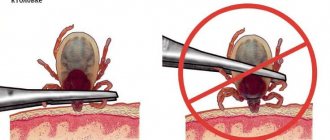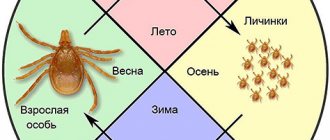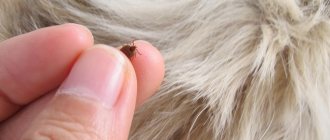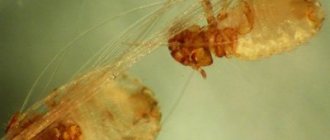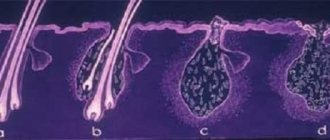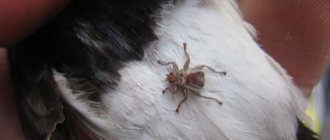Many pet owners don’t even think that a dog can die from a tick bite. You can encounter ticks in nature as early as April, so your dog needs to be treated with special products or wear an anti-tick collar. When a dog is bitten by a tick, symptoms and complications may not appear immediately. If a parasite was found on a pet, first of all it should be correctly removed, without leaving the head under the skin. Next, you need to monitor the pet’s condition, and if there are minor deviations in behavior, contact a veterinarian. If you do not notice the symptoms of a dangerous disease in time and do not contact a veterinarian, a tick bite can lead to the death of your dog.
Characteristics of the disease and its danger
Piroplasmosis in dogs, signs and treatment
Babesia enter the bloodstream, penetrate red blood cells, feed on the contents of the cell, and multiply. Severe anemia develops. The waste products of the parasite affect internal organs.
The functioning of the liver, kidneys, and pancreas is disrupted, and pulmonary edema develops. If the dog is not treated, it will die. Young purebred animals are most seriously ill. Adults and mongrel dogs tolerate the disease relatively easily.
Stages of disease development
The most common places of bites
Dogs get sick after being bitten by an ixodid tick. Arthropods live on low bushes, sense the approach of prey by air vibrations, heat, and carbon dioxide released during respiration.
In order for the eggs to mature, the female must receive complete protein. The arthropod jumps on the dog, travels around it, finds a secluded place, attaches to the skin, pierces it, and finds a capillary.
Ticks love the ears. To prevent the animal from worrying, the parasite injects an anesthetic and an anticoagulant to prevent blood clotting.
How does infection occur?
Ticks become active in early spring and pose a threat to pets and humans throughout the warm season. During frosts and droughts, parasites do not attack. The tick sucks out the first portion of blood and sends it to the intestines.
Food stimulates appetite and stimulates salivation. Along with saliva, pathogens enter the mammal's bloodstream. Babesia live in adult ticks and do not harm them.
The parasite penetrates the red blood cell. Immune cells - macrophages, absorb infected red cells, but do not kill piroplasms, spreading them throughout the body. A day passes from the moment the tick attaches to the invasion. If during this time the owner is able to remove the arthropod from the skin, infection will not occur.
Incubation period
It takes from 2 to 14 days from Babesia entering the bloodstream to the appearance of painful signs. The duration of the incubation period depends on the strength of the immune system and the number of attached ticks.
Painful symptoms appear when the number of Babesia reaches a critical level. When a protozoan parasite emerges from a destroyed red blood cell, toxic waste products are released into the blood.
Ixodid ticks - description
Ixodid ticks (family Ixodidae) in our zone are represented mainly by ticks of the genus Ixodes. This family includes the largest mites, measuring up to 4-5 mm. Unlike insects, ixodid ticks have eight limbs, not six; by this feature they can be distinguished from beetles. The body is flat, the color is usually dark brown or black, the head has a shield, which may be of a different color. A characteristic feature of ixodid ticks can also be considered the ability to significantly increase body size when sucking blood - up to 10 mm (twice). Such ticks are temporary parasites; they bite once, drink blood, and then fall away from the host, laying eggs and reproducing separately.
Contrary to popular belief, ticks do not live on tree branches, but on grass and low bushes. In our area they are found everywhere, including in parks and squares of Moscow, they can be found on any lawn (except those treated for ticks). Therefore, living in a large city or walking only in “civilized” places is not a guarantee of protecting your dog from ticks.
Piroplasmosis in dogs. Symptoms and signs
In the fulminant form of the disease, the dog dies suddenly, before symptoms appear. An acute course develops in young purebred animals.
The chronic form occurs in dogs that become ill again, mongrel pets or mixed breeds. Dogs vaccinated against piroplasmosis get sick, but in a mild form.
In acute form
An infected dog develops the following pathological symptoms:
- The animal looks depressed and lethargic;
- the pet refuses food;
- the mucous membranes first turn pale, then turn yellow;
- the temperature rises to 42 °C, hence the name of the pathogen: “pyroplasma”;
- pulse quickens;
- shortness of breath develops;
- urine becomes brown;
- Digestion is upset: vomiting and diarrhea occur;
- paralysis of the hind limbs develops.
These signs of the disease do not appear in all cases, but if at least some are detected, the dog owner needs to go to the clinic.
In chronic form
With the permanent form, the temperature fluctuates: the heat persists for several days and recedes. The pet diarrhea, loses weight, and gets tired quickly. The animal is capricious, its mood often changes, and the symptoms of anemia increase.
The dog recovers, but not completely; it develops chronic diseases of the internal organs.
First aid for a dog with a tick bite
When a tick is detected, first aid is provided: the parasite is picked up with tweezers, screwed in together with the head, and after removal it is burned. It is best to do this with gloves to avoid infection. A dog's skin wound must be disinfected. If the condition worsens, contact your veterinarian immediately. Before the specialist arrives, the dog is given clean water. If vomiting occurs, an enema is given or a subcutaneous injection is given.
If a dog is bitten by an encephalitis tick, the animal may die if help is not provided. Infection occurs quickly as the brain and nervous system are affected. At the first symptoms, the dog is taken to the clinic. After a bite, the pet becomes lethargic, the temperature rises, and there is no appetite. A white coating may appear on the mucous membranes. In such cases, the animal needs urgent help, since brain damage occurs quickly.
Diagnostics
The doctor makes a diagnosis based on clinical symptoms, medical history, and laboratory tests of the tick, which the dog’s owner brings to the clinic. The parasite is removed from the pet using a tick remover and placed in a bottle or zip bag.
If laboratory tests do not detect a pathogen, the dog is monitored and chemotherapy is not prescribed because the medications have side effects.
If the owner notices that the pet’s urine has darkened, it is taken for analysis. It is possible to detect the parasite in a blood smear no earlier than 2 weeks after the bite, so this research method is rarely used. If the doctor deems it necessary, the pathogen will be identified using a PCR test.
Beware, scammers!
Over the past two years, owners of sick animals have been increasingly deceived in Moscow. We have collected the most obvious signs that should make a dog owner wary.
Website without prices
When there are no prices on the website or it says that they will help solve the problem for an amount of 1000 rubles or more, the company will charge a lot. It's easy to refuse a service when you see the cost right away. But when they have already come to you and begun to examine the dog, then, willy-nilly, you agree to extortionate conditions.
Honest organizations immediately warn about the cost and do not hide it until a home visit. Of course, this is not the only sign of fraud. Therefore, you should first call by phone, find out the cost of the steps that we described in the block on treatment, and pay the organization strictly at the prices that were indicated to you in advance.
Free doctor call
They may write on the website that you either won’t have to pay for the call at all, or the amount will be up to 500 rubles. This is a trick, because this amount only includes the doctor’s visit, without an examination.
Then the scheme is simple: money is taken for every movement of the “specialist”. Take your temperature - pay, fill out your medical history - pay.
This adds up to 6,000 rubles. Then they begin to “rescue” the dog for 30,000 rubles.
And sometimes it reaches the point of absurdity: they offer to euthanize the animal under the pretext “it’s too late.” In fact, such organizations do not employ professional specialists, but make money from naive animal owners. Of course, it’s easier to put him to sleep and charge him for it.
Be careful.
Treatment
The treatment strategy is developing in the following directions:
- Resuscitation measures.
- Chemotherapy.
- Symptomatic treatment.
- Therapeutic diet.
- Rehabilitation.
When a dog arrives in serious condition, it is saved: drugs are used that support the activity of the heart, liver, kidneys, stop bleeding, and stop dehydration.
Piro-stop: Piroplasmosis in dogs, signs and treatment
The chemotherapy drug Piro-Stop based on imidocarb is administered once, the dosage is determined by the veterinarian. The antiprotozoal component accumulates in the liver and kidneys. The antimicrobial concentration is maintained for 4 to 6 weeks. After the injection, you must wait a quarter of an hour, because the death of parasites and destruction of red blood cells is accompanied by the release of toxic metabolites into the blood.
If signs of intoxication appear: vomiting, excessive salivation, muscle tremors, convulsions, use symptomatic medications.
Treatment lasts from 3 to 6 weeks. The effectiveness of therapy is assessed by blood and urine tests at intervals of 15-20 days. The doctor determines which internal organs have suffered the most and adjusts the treatment.
For a complete recovery, a course of rehabilitation is prescribed.
The following groups of drugs are used:
- multivitamins;
- detoxifiers;
- hepatoprotectors;
- iron supplements;
- immunomodulators.
The dog is considered recovered one month after the end of treatment, in the absence of pathological symptoms. The animal is limited in physical activity. You cannot take a sick dog hunting during the current year.
Symptoms of infection
The incubation period is the time when parasites actively reproduce. It lasts from 3 days to 4 weeks. Its development and duration depends on many factors:
- The dog’s age and health status at the time of the tick bite;
- The number of Babesia in the blood;
- Was vaccination carried out?
There are acute and chronic courses of the disease. Symptoms of acute piroplasmosis can be divided into two categories.
Primary signs:
- Frequent breathing and heartbeat;
- Weakness and lack of appetite;
- Body temperature rises to 42 degrees;
- Darkening of urine, bloody impurities, brown color;
- Diarrhea, vomiting.
These symptoms may appear as early as the third day after the tick bite. If the owner does not react and does not take the pet to the doctor, then the final signs of piroplasmosis will not be long in coming.
Final signs:
- The mucous membrane of the eyes acquires a yellow or blue tint;
- Yellowness of teeth in the most severe cases;
- Lack of appetite and watery stools that are jaundiced or green in color;
- Complete or partial numbness of the back of the body, rare spasms.
If you do not seek help from a veterinarian in time, death is possible within 3-7 days.
The danger of a chronic disease lies in its mild symptoms. The disease is indicated by the dog's constant depressive state. Then the dog’s health worsens: constipation alternates with diarrhea. Anemia progresses, the dog gets tired quickly and eats poorly. In this case, a blood test will show a decrease in red blood cells.
The chronic form of the disease is rare and occurs only in those dogs that have already suffered piroplasmosis once or have a strong immune system. In this situation, the disease lasts from 3 to 8 weeks. With proper treatment, the tailed pet recovers only after 3-6 months.
Diagnosis of the disease
To identify a dangerous disease, specialists conduct complex diagnostics. The correct diagnosis is confirmed based on examination and laboratory tests:
- Biochemical blood test;
- Serological research;
- Ultrasound of the kidneys;
- Urinalysis (to detect the presence of hemoglobin).
In advanced cases, the color of urine is almost black. This is due to severe damage to red blood cells. The tests may need to be repeated in a few days. After all, during the incubation period it is not always possible to immediately detect the presence of parasites in the blood of an animal.
What to feed a dog after piroplasmosis
You should not force feed a sick dog. With natural nutrition, the menu is drawn up together with a veterinarian. The basis of the diet is puree with pureed meat and porridge. Dry veterinary food for dogs with kidney or liver diseases has the best therapeutic effect.
In the first days, if there is poor appetite, the granules are soaked and given several times a day in small portions. After recovery, the veterinarian evaluates the animal’s condition and recommends remaining on medical nutrition or switching to a regular diet.
How we treat piroplasmosis at Biovetel
"Biovetel" is veterinary care at home in Moscow and the region. We employ veterinarians who have undergone internships and training in leading clinics in Moscow. More information about the experience of doctors, certificates and staff is written on the page about the company.
We will describe the treatment scenario so that you can clearly understand each step after calling help at home.
First of all, we confirm the diagnosis:
We draw blood for analysis. Treatment never begins with drug administration.
Then we evaluate the blood biochemistry picture
and a general blood test to understand the extent of damage to internal organs and the consequences of the disease for the body.
At the same time, we determine the condition of the animal.
If it is satisfactory or moderate with normal urine formation, then we prescribe treatment at home. If the condition is critical, we recommend taking you to a clinic for emergency care. We can accompany you to the clinic or take the dog with the owner ourselves.
If the animal’s condition allows it to be treated at home, then we put on a drip until it improves. Usually the procedure takes 2-3 days, after which we do repeated tests and switch to tablets.
There were cases when the owner could not monitor the dog for three days under a drip. In this case, Biovetel assigns a paramedic to provide assistance throughout the entire period of treatment.
If you like our approach, call 8 and we will advise on your problem.
Can babesiosis be transmitted to other animals or humans?
A tick that has drunk blood increases in size a hundred times. It falls off, falls to the ground and, after the eggs mature, dies. The tick cannot attack another victim again.
Babesia do not live in the human body, but arthropods carry pathogens of other dangerous diseases. When a person accidentally crushes a tick, he needs to immediately wash his hands.
If there is a scratch on the skin or your hands touch your eyes, you may become infected with encephalitis, borreliosis, anaplasmosis, or Crimean hemorrhagic fever.
We recommend reading:
- The best flea and tick drops for dogs
- Removing fleas from dogs, what to choose?
What to do
To save a dog after a bite, you need to provide first aid, remove the tick, place it in a bottle and take it to the clinic. There they will conduct a study to detect the DNA of pathogens and prescribe treatment.
If the tick turns out to be free of contagion, observe the dog and remember that pathological symptoms may appear several months after the bite.
First aid for a bite at home
If you find a tick, it must be safely removed.
Don’t panic, even if the arthropod is infected, it takes a day or more for the pathogens to reach the salivary glands of the parasite.
However, one cannot be careless. There may be microorganisms inside the tick that can cause human illness. When crushed, protozoa or bacteria can enter the bloodstream through mucous membranes or skin pores. Therefore, wear gloves.
The opinion that a tick can be killed by lubricating the spiracles with oil is unfounded. The arthropod can live without oxygen for more than a day. During this time, pathogens will enter the bloodstream. Applying an insecticide to the parasite does not always help. The tick will not die soon, but the dog will have time to become infected.
Do not remove an attached parasite with tweezers.
If limbs or the head remain in the wound after a bite, inflammation will develop.
Use professional tick removers.
I tried to pull out the tick with Anti-Tick tweezers. I did not like. The inflated parasite burst, blood sprayed out, it’s good that he dodged and didn’t get a jet in his eyes.
Anti-mite
Perhaps this is my subjective opinion. But Tik Twister delighted me. I turned the tick out the first time.
Tick Twister
The device resembles a nail puller and costs about 160 rubles. Watch the video and rate.
Recommended reading:
How to remove a tick from a dog?
If you removed the parasite carelessly, after the tick bite a lump may form that is dense and painless to the touch.
Most often, the tumor does not cause harm and is an allergic response to the secretions left by the arthropod. Perhaps the affected area was itchy and the pet scratched it. But the red spot spoils the appearance and can remain at the site of the bite for up to six months.
In any case, observe your pet for 15-20 days. If the dog's behavior has not changed, the mucous membranes have not turned pale or yellowed, it eats well, is active and cheerful, everything is fine.
If a tick leg remains in the wound , the formation will gradually resolve. But when the head remains, there is a high probability of suppuration and the formation of an abscess. Do not fix the defect yourself. You may cause skin irritation that may result in eczema or another type of dermatitis that is difficult to treat. Visit a veterinary hospital and take the medicine prescribed by your doctor.
When you find a dead tick on your dog , pay attention to its size. If it has sucked blood, then take the parasite to a hospital for examination to determine what contagions are inside it. If the arthropod is small, test anyway. You may have used acaricides that killed the parasite. Or the dog snapped his teeth and crushed the arthropod. But there is no guarantee that other ticks will also die. Therefore, it is better to know whether he is infected or not?
I foresee questions about what to do when you are in the forest, at the dacha, there are no veterinary clinics around, and a tick has bitten your dog? Responsible dog breeders, before going into nature, go to a hospital so that the pet can be given an antiprotozoal drug, for example, Piro-Stop, for preventive purposes.
The veterinary industry produces antiprotozoal drugs that are used to kill Babesia after a tick bite based on imidocarb or diminazene aceturate.
Imidocarb derivatives - Piro-Stop, Forticarb, Babezan are produced in solution, are relatively harmless and high in cost (a 10 ml bottle of Piro-Stop - 524 rubles). After opening the container, the medicine must be developed within 28 days.
Medicines based on diminazene aceturate - Azidine, Berenil, Veriben, Pirosan - are produced in powders that are dissolved before use. The drugs are effective and inexpensive (2.4 g of Azidine sells for 30 rubles), but have side effects.
If you risk using the drugs yourself, there is a high probability that you will save the dog, but make it disabled. On the Internet you will definitely run into advice from amateurs like yourself. Therefore, contact your veterinarian by phone and follow his instructions.


